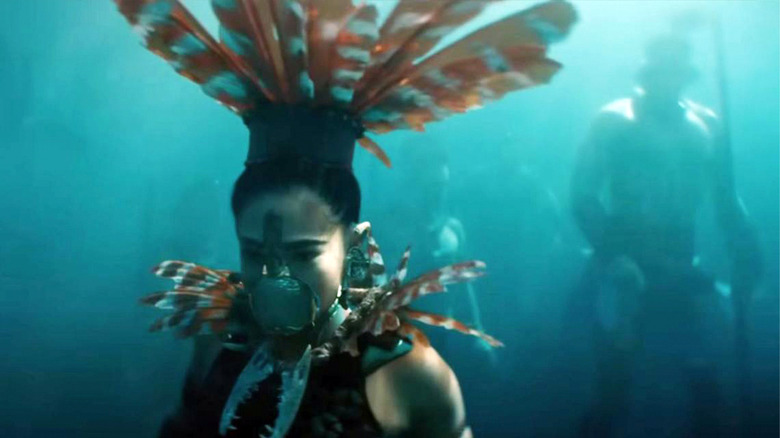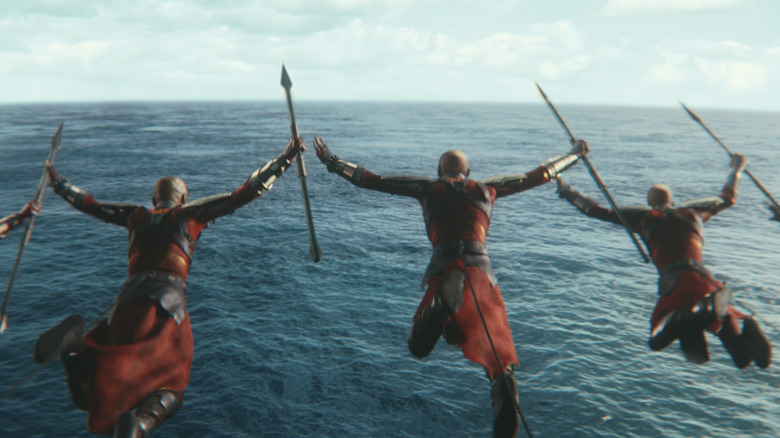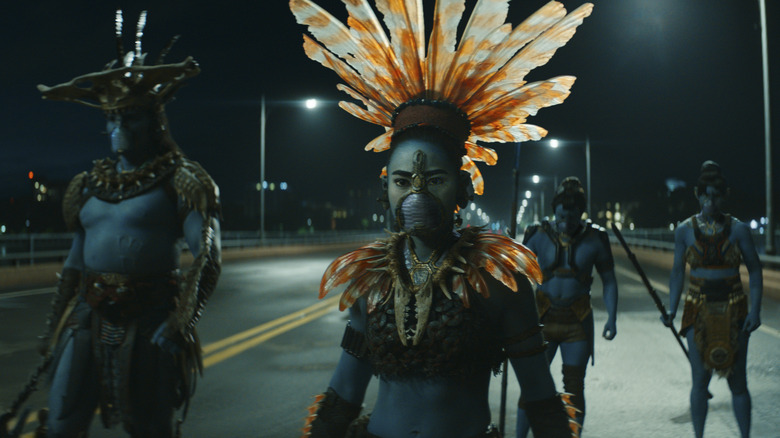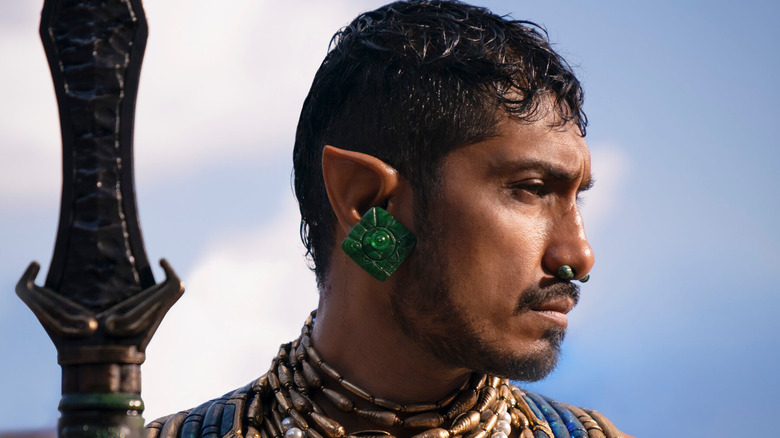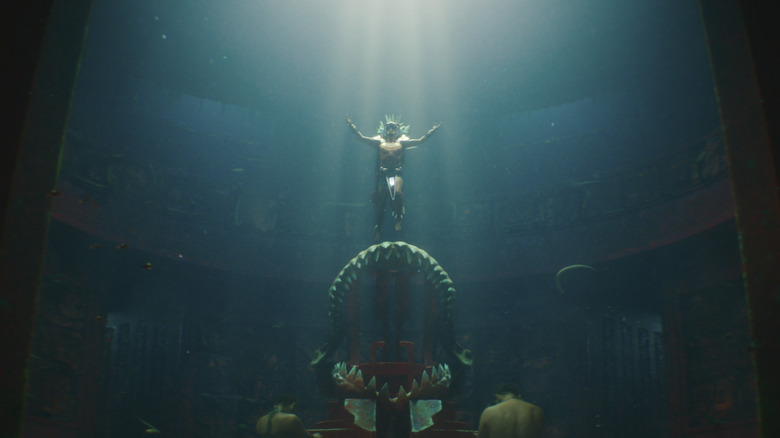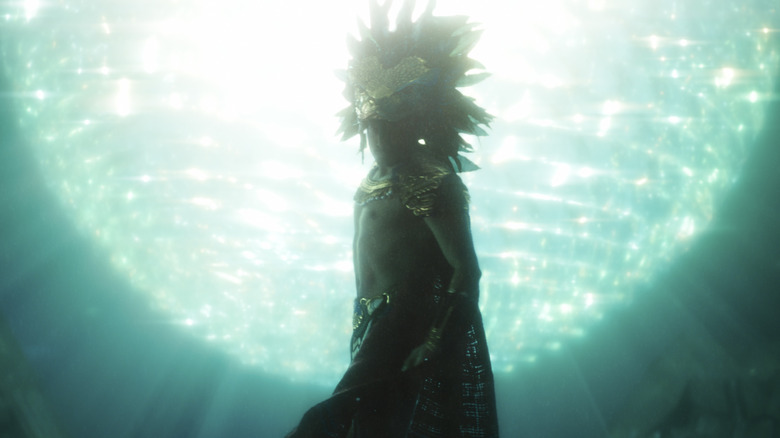How Black Panther: Wakanda Forever's Water Scenes Came Together
"Black Panther: Wakanda Forever" is caught between two worlds. That's nothing new for a movie set in the Marvel Cinematic Universe, where audiences are frequently whisked off into space or transported to separate dimensions a la the multiverse — but this movie does things a little differently. No wizard portals or futuristic ships are required because we never actually leave the planet Earth. Instead, the people of Wakanda come to realize that they aren't the only super-advanced vibranium-hoarding country on the planet.
In revealing itself to the world, Wakanda has made an enemy of a society that preferred to exist in the shadows. Or better yet, in the depths of the ocean, where no one was the wiser.
Yes, in between making audiences cheer and making them cry, "Wakanda Forever" also finds time to amaze audiences with the underwater kingdom of Talokan. Under the rule of their king Namor (Tenoch Huerta Mejia), the people of Talokan have built a society so powerful that it rivals Wakanda, vibranium stash and all. But the Talokanil also have an extra chip in their favor: They can harness the power of the ocean to their advantage. Like sirens, they can lure innocents to a watery grave and like Aquaman, they can call upon sea life for favors.
And as badass as they are in action, those ocean-based abilities are also where "Wakanda Forever" gets complicated. The challenges created by Talokan aren't just limited to the characters themselves — creating an underwater world was also a struggle for the folks working behind the scenes on this movie.
Coogler and his cast learned how to swim
The first rule of filming a movie about an underwater society? Learn how to swim. Writer-director Ryan Coogler had to learn that lesson the hard way. In penning the next chapter of Wakanda's story, Coogler had written a film where a good chunk of scenes took place in the depths of the ocean — which meant it was time to don a swimsuit and learn how to dive. Or as Coogler explained to Variety, "If the camera's in the water [and] actors are in the water, I've got to be in there too."
Prior to filming, Coogler's swimming expertise was nonexistent — and he wasn't alone. Although Nakia gets tasked with an underwater rescue mission, Lupita Nyong'o was not a confident swimmer before production began. The same was true for Bassett, which is why they enlisted the help of trained professionals "You know, Black girls have this history with water and their hair," Bassett quipped in the same interview. "Some of us can't swim all that well, because it's going to mess up that press and curl. It's a whole thing."
But that's one of the beauties of this movie — no one is safe from the watery depths of Wakanda's newest adversaries. As the Wakandans try to navigate the conflict, they continuously find themselves fighting on the Talokanil's home turf, surrounded by the ocean. So at one point or another, everyone ends up submerged.
"It was brilliant because the script called for all of our lead actors and supporting actors to get in the water, at some point," Coogler told Marvel.com. "Whether that was on a set, whether they were submerging into a water tank, it was like a rite of passage for everybody."
Talokan's wetest warriors
Naturally, the three actors who spent the most time in the water were playing the Talokanil — Namor (Tenoch Huerta Mejía), Attuma (Alex Livinalli), and Namora (Mabel Cadena). While Huerta knew that would be the case as soon as he signed on, he made sure to, uh, creatively avoid the question when Coogler first approached him for the role. When asked if he already knew how to swim, Huerta reportedly answered, "I've never drowned before." After booking the role, he started taking lessons. But learning to swim and learning to act underwater are two very different things.
Cadena put it bluntly, explaining her mindset when filming first began: "I know how to do my job but I don't know how to do the job underwater." Adjusting to their time in the water tanks took a lot of training and as production progressed, Cadena found herself excelling. In fact, she holds the cast record for holding her breath the longest — a whopping six and a half minutes. Her advice for following in her footsteps? "The first rule is 'Don't feel panic.'" But that's easier said than done. Livinalli told Variety that he panicked the minute he was in the tank:
"I remember the first few days I went in the tank, you go in there and you start feeling the panic. It's a process: getting your mind into that relaxation state, learning to maximize your oxygen. And [Mabel] definitely maximized it."
Cadena was so comfortable underwater that she basically become a Talokanil herself! She added,
"I asked Ryan, 'Hey, please let me do everything because I'm ready to do this.' It was amazing to work underwater. I think the [early] pre-diving gave me the opportunity to have mental strength. You don't need just the physical strength, you need the mental strength for a job like this."
Namor's crowning achievement
Learning to maximize their oxygen was just one part of the process. Once they had the basics of not drowning down, the actors had to get used to performing underwater. "Visibility there is horrible, you can't see well enough," Livinalli told Marvel. He explained:
"There were scenes [with Mabel] that happened literally next to me, and she looked like a video game from the '90s. It was a lot of mental memory of what the set looked like, of where she's placed, where the camera is placed."
In the end, none of those struggles are evident in the performances. That much was clear to Coogler even before editing the final project. In the same interview, he recalled filming a version of Namor's rallying monologue in Talokan — which Huerta initially delivered underwater.
"He performed a whole monologue, not his native language, underwater, 10 feet underwater in that giant megalodon throne! It was just for us to feel what it would feel like, what it would look like to see somebody actually speak underwater. He had this insane headdress on. I mean, it was bonkers."
Though no one could actually hear him, Huerta gave it his all — and enjoyed every second of it.
"I was on that throne with the helmet and all the things around the people in front of me and it felt so good. It was a powerful sensation, and I was able to hold my breath for a long time ... it was such a great experience. I loved that scene."
Creating an underwater world from scratch
The logistical struggles of filming "Wakanda Forever" weren't just difficult for the cast. The production crew quickly realized that sets and costumes needed to be submerged along with the actors, presenting a brand new set of challenges.
Coogler said, "[Production designer] Hannah [Beachler] would build the sets, and then submerge them and the concrete was producing all these air bubbles. Then we couldn't shoot. They had to rebuild it with a particular type of concrete." And so they did, finding a way around the problem that was crucial to the final film: seeing the greatness of Talokan, its architecture and its people reminds us what Namor is striving to protect.
A similar issue arose with the costumes. Coogler told Marvel that "[Costume designer] Ruth Carter built these incredible costumes, and then we put them in the water, and it just totally changed." The Oscar-winning costume designer later explained the dilemma to Vanity Fair:
"After someone's in the water, in and out of the water all day in a costume, how do the fabrics survive? Things bled. They faded. They had to put chemicals in the water. It was impossible, but we made it."
Dressing the Talokanil
Carter now has a philosophy about this: "If you are asked to do a movie and they say there's water, hang up," she joked. For the costumes, as with the sets, the end result was stunning and extremely purposeful. Carter explained that the idea for the Talokanil people was to connect their costumes back to Mayan culture while utilizing everything from kelp leaves and fish bones to emulate the sea. "It was a beautiful love letter to their culture and also a look into the possibilities of Latin futurism."
Despite all the complications, everyone joining forces on "Wakanda Forever" rose to the occasion. Proud of his team and what they accomplished, Coogler said, "We did a lot of things that were definitely cutting-edge, for me as a filmmaker."
"Black Panther: Wakanda Forever" is now playing in theaters.
